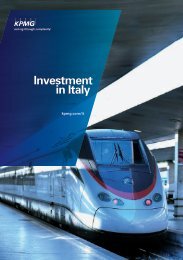Innovation Canada: A Call to Action
Innovation Canada: A Call to Action
Innovation Canada: A Call to Action
You also want an ePaper? Increase the reach of your titles
YUMPU automatically turns print PDFs into web optimized ePapers that Google loves.
<strong>Innovation</strong> <strong>Canada</strong>: A <strong>Call</strong> <strong>to</strong> <strong>Action</strong>companies address commercializationchallenges by turning those challenges in<strong>to</strong>student-led applied research problems. Collegesand polytechnics also directly assist firms withtheir innovation needs — this is the case, forexample, with the long-standing CollegeCentres for the Transfer of Technologiesassociated with Quebec colleges and Cégeps,which assist innovative companies throughtechnical support, technological development,and information and training (see alsoFigure 2.6). Government labora<strong>to</strong>ries,meanwhile, conduct science in support ofpublic policy mandates as well is in relation <strong>to</strong>certain commercially oriented activities.<strong>Innovation</strong> Input:Talented, Educated andEntrepreneurial People<strong>Canada</strong>’s future as an innovation-basedeconomy depends on ensuring there aresufficient numbers of talented, educated andentrepreneurial people. The primary source ofsuch talent is our public post-secondaryeducation institutions — the universities,polytechnics and community colleges (includingCégeps in Quebec) that produce the innova<strong>to</strong>rsand those who support innovative activity. Theseinstitutions are primarily funded through theprovinces, although the federal governmentplays a role through transfer payments, studentfinancial assistance and direct support forresearch training and innovation skillsenhancements. The diversity of highereducation institutions with varying missions andmandates provides <strong>Canada</strong> with the highlyqualified and skilled people who are thebedrock of innovation. Each of these postsecondaryeducation institutions has a uniquerole <strong>to</strong> play, producing workers for differentcomponents of the innovation ecosystem. Ouruniversity graduate programs produce theadvanced Master’s and PhD degree holders whocan contribute breakthrough ideas that canensure companies stay at the cutting edge ofR&D; our universities and colleges produceBachelor’s degree holders who are often thefront-line innovation performers; and ourcolleges produce technicians and technologists<strong>to</strong> facilitate the commercialization efforts ofthe firm. 1It is the interplay among these complementarytypes of talent that builds an innovationeconomy. Since <strong>Canada</strong>’s innovation gap ispartly an education gap, improving our globalperformance will require the right mix in boththe quantity and quality of talent. This demandsa collaborative approach that brings <strong>to</strong>getherour post-secondary institutions, federal andprovincial agencies as well as industry and otherpartners <strong>to</strong> ensure appropriate recruitment,training and deployment for industrialinnovation needs. While <strong>Canada</strong> ranks first inthe OECD for the percentage of its populationwith post-secondary attainment, it is middle ofthe pack in baccalaureate output and near thebot<strong>to</strong>m for the number of doc<strong>to</strong>ral graduatesper capita. It is nevertheless encouraging thatthe growth in the number of doc<strong>to</strong>ral degreesgranted in <strong>Canada</strong> has been stronger —particularly in science and engineering — thanin most comparable countries over the 2005–08period, helping <strong>to</strong> improve our relative position(STIC 2011).The earnings advantage of individuals withadvanced degrees (relative <strong>to</strong> high schoolgraduates) is less pronounced in <strong>Canada</strong> than inthe US (Institute for Competitiveness &1 <strong>Canada</strong>’s rich and diverse landscape of about 250 post-secondary institutions includes 152 colleges, of which about 48 areCégeps in Quebec, some are degree granting, some are known as institutes of technology and some are known aspolytechnics. Many colleges are emerging ac<strong>to</strong>rs in downstream innovation near the commercialization activities of smalland medium-sized enterprises. There are 95 universities throughout <strong>Canada</strong>, many of which have world-class researchcapabilities.2-14
















